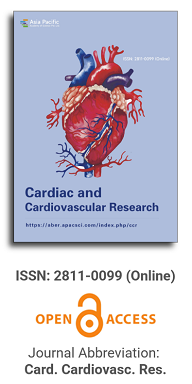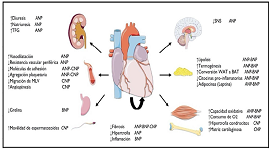
Asia Pacific Academy of Science Pte. Ltd. (APACSCI) specializes in international journal publishing. APACSCI adopts the open access publishing model and provides an important communication bridge for academic groups whose interest fields include engineering, technology, medicine, computer, mathematics, agriculture and forestry, and environment.

Smoking cessation in cardiovascular health
Vol 1, Issue 1, 2020
Download PDF
Abstract
The World Health Organization has identified noncommunicable diseases (NCDs) as one of the greatest challenges of this century, accounting for 71% of deaths worldwide. Smoking is considered one of the main modifiable risk factors affecting NCDs. There is ample evidence linking smoking to cardiovascular disease, particularly ischemic heart disease. The 2016 European Society of Cardiology Cardiovascular Prevention Guidelines establish smoking cessation as a class I, level of evidence A recommendation. The effect of nicotine generates a strong addiction that triggers a withdrawal syndrome when attempting to quit smoking. Therefore, it is necessary to be familiar with the strategies for the treatment of tobacco addiction, which include: minimal intervention, cognitive-behavioral resources and pharmacological treatment such as nicotine replacement therapy, bupropion and varenicline. At present, there is insufficient scientific evidence to recommend electronic devices.
Keywords
References
- World Health Organization. Global status report on noncommunicable diseases 2014. Geneva: WHO; 2014.
- World Health Organization. Noncommunicable diseases: 1 June 2018. Geneva: WHO; 2018.
- GBD 2015 Risk Factors Collaborators. Global, regional, and national comparative risk assessment of 79 behavioral, environmental and occupational, and metabolic risks or clusters of risks, 1990-2015: a systematic analysis for the Global Burden of Disease Study 2015. Lancet. 2016; 388(10053): 1659-1724.
- Beaglehole R, Bonita R, Horton R, et al. Priority actions for the non-communicable disease crisis. Lancet. 2011; 377(9775): 1438–1447.
- Zabert G, Jiménez Ruiz C, Zabert I. What should cardiologists know about pharmacological treatment for smoking cessation? Rev Urug Cardiol. 2011; 26(3): 251–262.
- World Health Organization. Guidelines on protection from exposure to tobacco smoke: purpose, objectives and main considerations. Geneva: WHO; 2007.
- Ambrose J, Barua R. The pathophysiology of cigarette smoking and cardiovascular disease: an update. J Am Coll Cardiol. 2004; 43(10): 1731–1737.
- Sandoya E, Sebrié E, Bianco E, et al. Impact of indoor smoking bans on admissions for acute myocardial infarction in Uruguay. Rev Méd Urug. 2010; 26(4): 206–215.
- Raupach T, Schäfer K, Konstantinides S, Andreas S. Secondhand smoke as an acute threat for the cardiovascular system: a change in paradigm. Eur Heart J. 2006; 27(4): 386–392.
- Teo K, Ounpuu S, Hawken S, et al. Tobacco use and risk of myocardial infarction in 52 countries in the INTERHEART study: a case-control study. Lancet. 2006; 368(9536): 647–658.
- Doll R, Peto R, Boreham J, Sutherland I. Mortality in relation to smoking: 50 years’ observations on male British doctors. BMJ. 2004; 328(7455): 1519.
- Barnoya J, Glantz S. Cardiovascular effects of second hand smoke: nearly as large as smoking. Circulation. 2005; 111(20): 2684–2698.
- Sebrié E, Sandoya E, Hyland A, et al. Hospital admissions for acute myo cardial infarction before and after implementation of a comprehensive smoke-free policy in Uruguay. Tob Control. 2013; 22(e1): e16–20.
- National Resources Fund. World tobacco-free day: communication made on May 31, 2018. Montevideo: FNR; 2018.
- Prescott E, Hippe M, Schnohr P, et al. Smoking and risk of myocardial infarction in women and men: longitudinal population study. BMJ. 1998; 316(7137): 1043–1047.
- Spanish Society of Cardiology. ESC 2016 guideline on prevention of cardiovascular disease in clinical practice. Rev Esp Cardiol. 2016; 69(10): 939.e1–e87.
- Lorenzo García A, Baraibar Penco R, Melgar Álvarez S, et al. Guía Nacional para el Abordaje del Tabaquismo: Uruguay 2009. Montevideo: MSP; 2009.
- Chow C, Jolly S, Rao-Melacini P, et al. Association of diet, exercise, and smoking modification with risk of early cardiovascular events after acute coronary syndromes. Circulation. 2010; 121(6): 750–758.
- Di Chiara G. Role of dopamine in the behavioral actions of nicotine related to addiction. Eur J Pharmacol. 2000; 393(1–3): 295–314.
- Hughes J. Effects of abstinence from tobacco: valid symptoms and time course. Nicotine Tob Res. 2007; 9(3): 315–327.
- McRobbie H, Thornley S. The importance of treating tobacco dependence. Rev Esp Cardiol. 2008; 61(6): 620–628.
- Shiffman S, Brockwell S, Pillitteri J, Gitchell J. Use of smoking-cessation treatments in the Uni- ted States. Am J Prev Med. 2008; 34(2): 102–111.
- Hughes J, Keely J, Naud S. Shape of the relapse curve and long-term abstinence among untreated smokers. Addiction. 2004; 99(1): 29-38.
- Uruguay. Ministry of Health. Global adult smoking survey: Global Adult Tobacco Survey (GATS) Uruguay 2017. Available online: http://www.msp.gub.uy/sites/default/files/archi-vos_adjuntos/PRESENTACI%C3%93N% 20GATS_Mayo%202017%20%28edit%29.ppt (accessed on 2 June 2020).
- Lader D. Smoking-related behaviour and attitudes, 2006: a report on research using the National Statis- tics Omnibus Survey produced on behalf of the Infor- mation Centre for health and social care. Newport, UK: Office for National Statistics; 2007.
- United States. Department of Health and Human Services. Treating tobacco use and dependence. Rockville, MD: Department of Health and Human Services; 2000.
- Stead L, Buitrago D, Preciado N, et al. Physician advice for smoking cessation. Cochrane Database Syst Rev. 2013; (5): CD000165. doi: 10.1002/14651858.CD000165
- World Health Organization. Electronic nicotine delivery systems and nicotine-free systems (SEAN/SSSN). In: Proceedings of Seventh Meeting of the Conference of the Parties to the WHO Framework Convention on Tobacco Control, Delhi; 7-12 November 2016.
- Hughes J, Stead L, Lancaster T. Antidepressants for smoking cessation. Cochrane Database Syst Rev. 2007; (1): CD000031
- Rollema H, Hajós M, Seymour P, et al. Preclinical pharmacology of the alpha4 beta2 nAChR partial agonist varenicline related to effects on reward, mood and cognition. Biochem Pharmacol. 2009; 78(7): 813-824.
- Jiménez Ruiz C, Jaén C. Tobacco dependence treatment guide. [Treating tobacco use and dependence: 2008 update. Clinical practice guideline of U.S. Department of Health and Human Services. Public Health Service; 2008.
- Bhatnagar A, Whitsel L, Ribisl K, et al. Electronic Cigarrettes: a policy statement from the American Heart Association. Circulation. 2014; 130(16):1418–1436.
- Doval H, Tajer C. Evidence in Cardiology (Spanish), 8th ed. Buenos Aires: GEDIC; 2016.
Supporting Agencies
Copyright (c) 2020 Dres. Enrique Soto, Ana Lorenzo, Elba Esteves

This work is licensed under a Creative Commons Attribution 4.0 International License.

This site is licensed under a Creative Commons Attribution 4.0 International License (CC BY 4.0).

Prof. Prakash Deedwania
University of California,
San Francisco, United States




